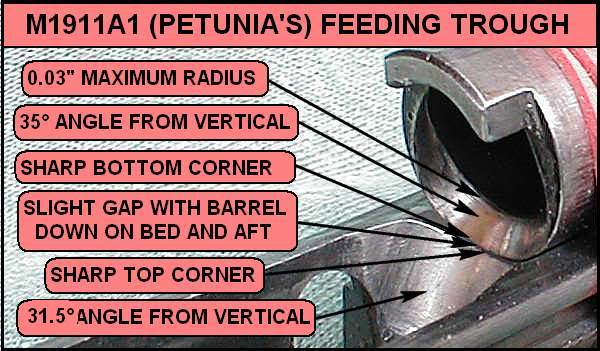
Both failures were when I inserted a fresh magazine and "slingshot" the slide forward. One magazine was the standard Ed Brown 7 rounder, the other was an Ed Brown 8 Pack. After each failure, I dropped the magazine, reloaded the round, re-inserted the magazine, "slingshot" the slide forward and the round chambered and fired.
I came home and read some more and tested my extractor by taking the slide off and placing a round under the extractor and lightly shaking it, the round did not fall out leading me to believe the extractor tension is okay (at least that's the way I read it).
The only thing I noticed which may or may not be normal is a little brass coloring on the inside of the slide stop. Seems that it's possible rounds are slightly rubbing the inside of the slide stop. Is this something which shouldn't be happening or is it normal? I tried searching and could only find that rounds rubbing the inside of the slide stop may cause an early slide lock issue which I am not having.
I figure I'm going to shoot another 4-500 rounds through it and hopefully see the failure to feed issue go away.
I have no pictures of the double feeds which I'm not concerned about since they didn't occur on my second day at the range and I'll attribute to me getting oil/grease on or in my magazines.
I didn't take a picture of the two failures to feed on my second range day as I was Ill prepared with a camera. The rounds were parallel to the magazine, not really pointing down or up.
PICTURES 404
Quote:
I experienced 1 failure to feed in which the round basically stopped level
at the feed ramp. This occurred after approximately 75 rounds. It was the
first round in the magazine in which I inserted it and "slingshot" the slide
forward.
A level round seems to indicate the nose of the bullet got stuck at the junction of the frame and barrel ramps. Take the slide off, link the barrel to the frame, push the barrel all the way back with its aft end down on the barrel bed and give us a photo like this so we can see how the bottom of the barrel ramp meets the top of the frame ramp:

Should you have more of these jams, don't fire those rounds. Instead, carefully extract them, measure their OAL's and find out how much the bullets got pushed back into the case. The first round out a full magazine (especially an extra capacity magazine) is the most difficult for any 1911 to feed because it will hit way down low on the feed ramp and when the bullet gets pushed back in its case the feeding is even more difficult.
OK, the photos added to Post #1 show the barrel ramp doesn't hang back over the top of the frame ramp and the top corner of the frame ramp is nice and sharp, so that's OK.
Notice all those marks on the ramp where the bullets have been hitting? That's because they (especially the first few out of the magazine) nosedive down low onto the ramp - and that is completely normal. What's not normal is for those nosediving rounds to jam. And they jam when they don't glance briskly up and off of the ramp on their way into the chamber. That's because if they don't glance up and off of the ramp they slide up along the ramp and rob the slide of energy. And one of the primary reasons why a bullet slided up along the ramp is because it got pushed back into its case upon hitting the ramp.
A bullet gets shoved back because its case has a poor grip on it. And there a wide variety of case grips - but the details would fill pages. So here's just a summary of tests I've done on these commercial ammunitions:
PICTURE 404
The ammunition with the smallest number rating has a better chance of making it all the way into the chamber. Other things that will help:
* Avoid extra capacity magazines - they cause the first rounds to nosedive even further.
* Use lots of oil on the frame & slide rails & ways. Lots. Gurgle, gurgle lots.
Quote:
Would the fact that rounds are rubbing the inside of the slide stop come
into play on a failure to feed? I'm guessing the more rounds I put through it
the less rubbing will occur (which I don't mind unless were talking thousands
of rounds here).
I vote: Yes
Not only does this slide stop interference influence how the ammo feeds it also tends to rob recoil spring energy and may contribute to a FTRTB. It can even push the slide stop far enough out that you may have problems locking the slide back on the last round.
Just an update with a picture or two included.
Since the original date of the post, i've had time to make two more range trips. Before doing so, I cleaned all my magazines and lubed the gun with oil only.
On the second range trip, I put 200 rounds total (100 of magtech 230 grn FMJ and 100 of Win. RA45T). I experienced two "nosedive" failures to feed with the RA45T. Each was the first round in the magazine (one 7 rounder and one 8 rounder). No other issues.
On the third range trip, I put 200 rounds total (150 of magtech and 50 of mixed Win. RA45T, Fed. HST and Speer Gold Dot). No failures at all.
This puts me at 619 rounds total with the last range trip being failure free. I hope to run approximately 500-700 more rounds through it with no failures and call it good!